How Data Cleansing Drives Better Analytics Results
Dirty data can cost businesses 15% to 25% of their revenue, making it a silent yet costly problem. It leads to flawed analytics, unreliable insights, and wasted resources. For example, a major retail chain once suffered massive losses due to a missing database entry that caused incorrect pricing during sales. This highlights the critical need for error-free data. Data cleansing ensures your data is accurate, consistent, and complete. By prioritizing the importance of data cleaning, you can build trust in analytics, improve decision-making, and avoid costly mistakes.
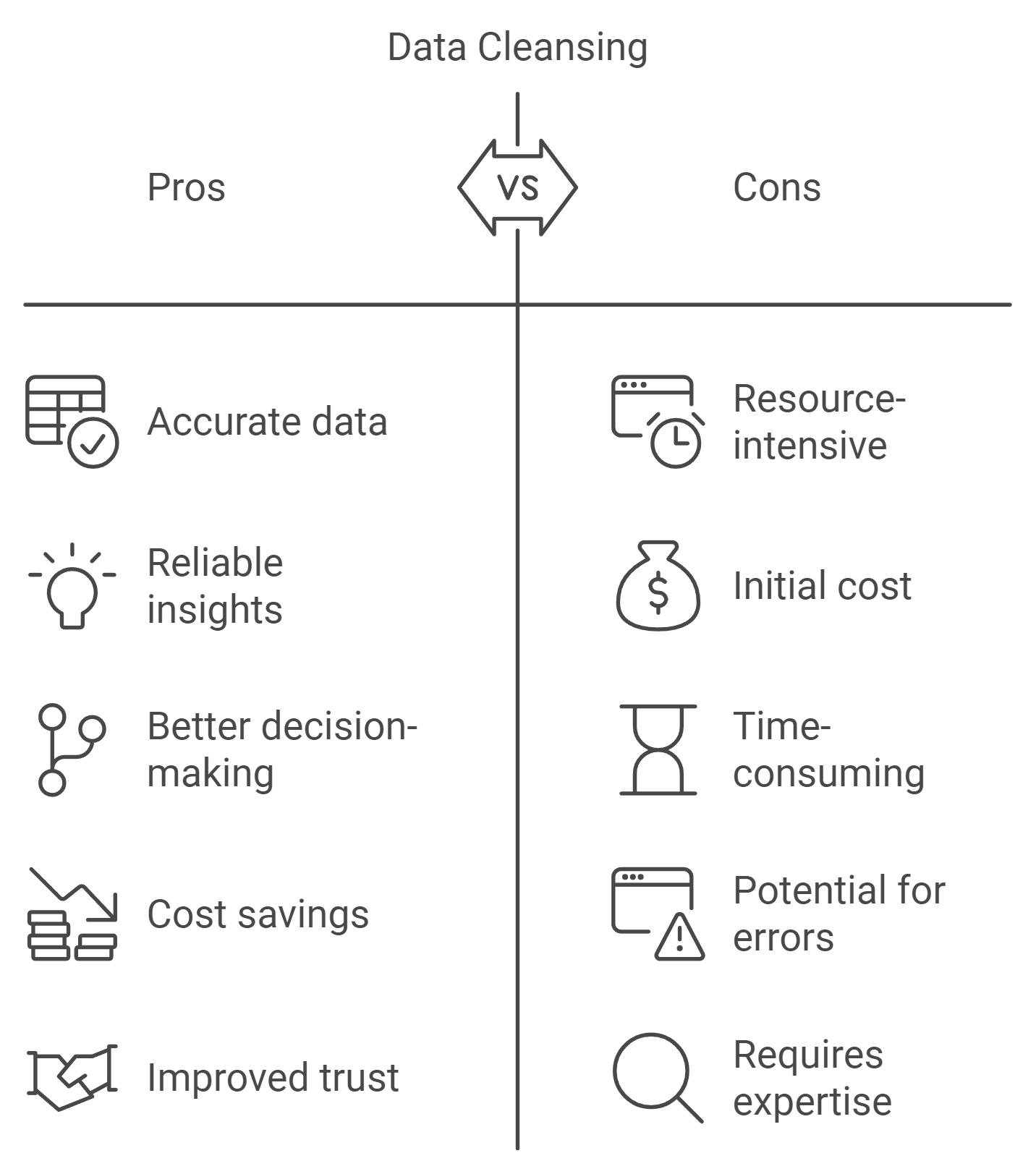
Key Takeaways
Dirty data can cost businesses 15% to 25% of their revenue, making data cleansing essential for financial health.
Clean data enhances analytics accuracy, allowing for reliable insights and informed decision-making.
Implementing data cleansing processes, such as deduplication and standardization, can significantly improve operational efficiency.
Regular data audits and automated tools are crucial for maintaining data quality and preventing errors from accumulating.
Investing in data cleansing fosters stakeholder trust, as reliable data strengthens relationships and supports collaboration.
Clean data not only drives better analytics results but also supports sustainable growth and adaptability in a changing market.
Understanding Data Cleansing
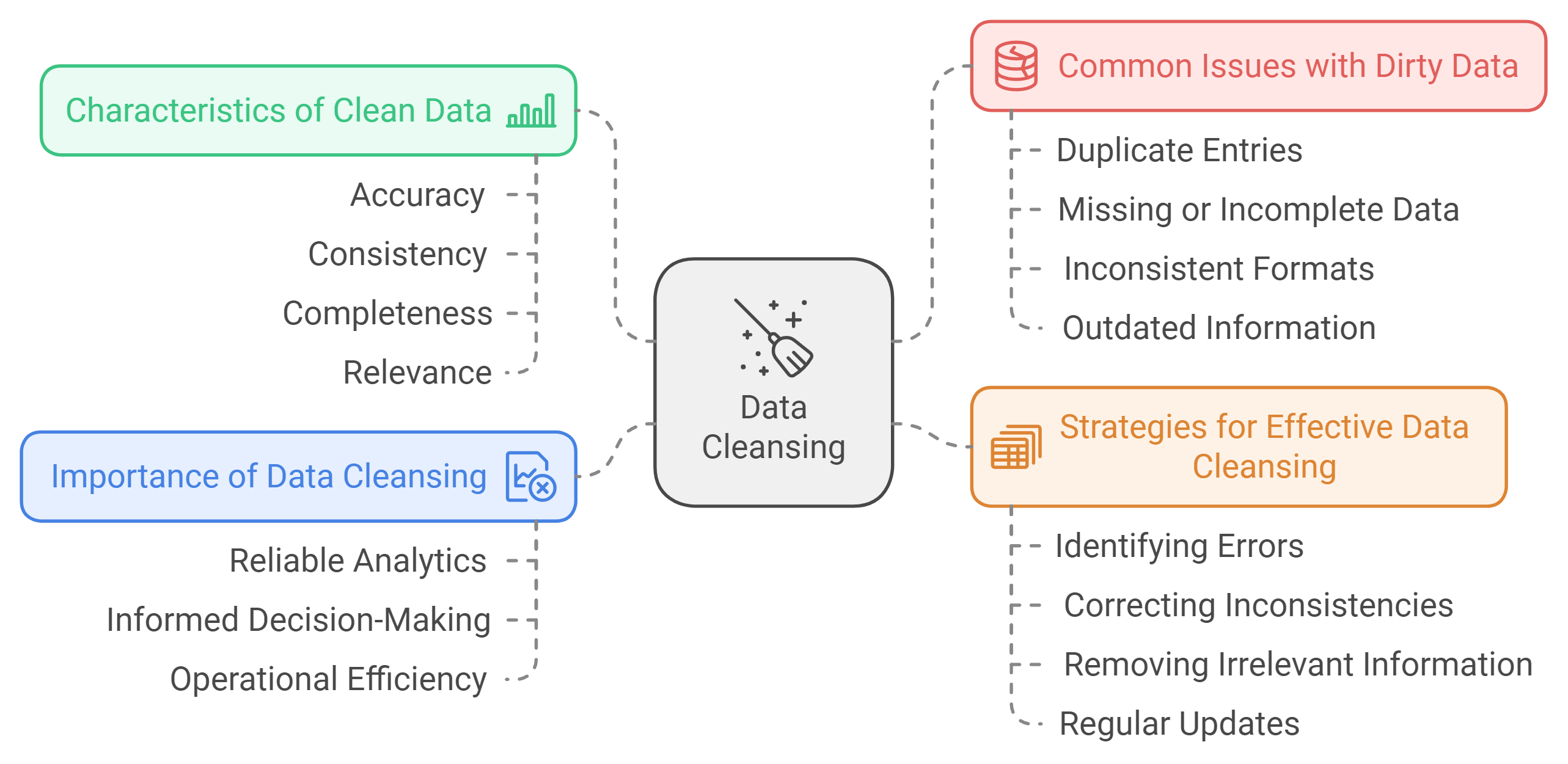
What is Data Cleansing?
Data cleansing is the process of identifying and correcting errors, inconsistencies, and inaccuracies in your datasets. It ensures that your data is accurate, complete, and ready for analysis. By removing irrelevant or incorrect information, you create a reliable foundation for analytics. This process is essential for businesses that rely on data-driven decisions. Without clean data, your insights may lead to costly mistakes or missed opportunities.
According to the Clarity Software Blog, data cleansing transforms raw data into accurate and correct information, making it a critical step in preparing data for analysis.
Characteristics of Clean Data
Clean data possesses specific qualities that make it valuable for analytics. These characteristics ensure that your data delivers meaningful insights:
Accuracy: The data reflects real-world values without errors.
Consistency: Uniform formatting and structure across all records.
Completeness: No missing fields or incomplete entries.
Relevance: Only includes data that serves your analytical goals.
When your data meets these standards, it becomes a powerful tool for decision-making. Clean data enhances reliability and builds confidence in your analytics.
Common Issues with Dirty Data
Dirty data can disrupt your analytics and lead to flawed conclusions. Understanding common issues helps you identify and address them effectively.
Duplicate Entries
Duplicate entries occur when the same data appears multiple times in your dataset. These duplicates skew your analysis and inflate metrics. For example, duplicate customer records can lead to inaccurate sales forecasts or marketing reports.
Missing or Incomplete Data
Missing or incomplete data creates gaps in your analysis. When key fields are empty, your insights become unreliable. For instance, incomplete customer profiles may hinder personalized marketing efforts.
Inconsistent Formats
Inconsistent formats make it difficult to analyze data accurately. Variations in date formats, currency symbols, or measurement units can cause errors during processing. Standardizing formats ensures seamless integration and analysis.
Outdated Information
Outdated information reduces the relevance of your data. Using old or obsolete records can lead to poor decisions. Regular updates keep your data current and aligned with your business needs.
The Managed Outsource Blog highlights that addressing these issues through effective data cleansing strategies significantly improves data reliability and usability.
By tackling these common problems, you can unlock the full potential of your data. Clean data not only enhances analytics but also supports informed decision-making and operational efficiency.
Why Data Cleansing is Crucial for Analytics
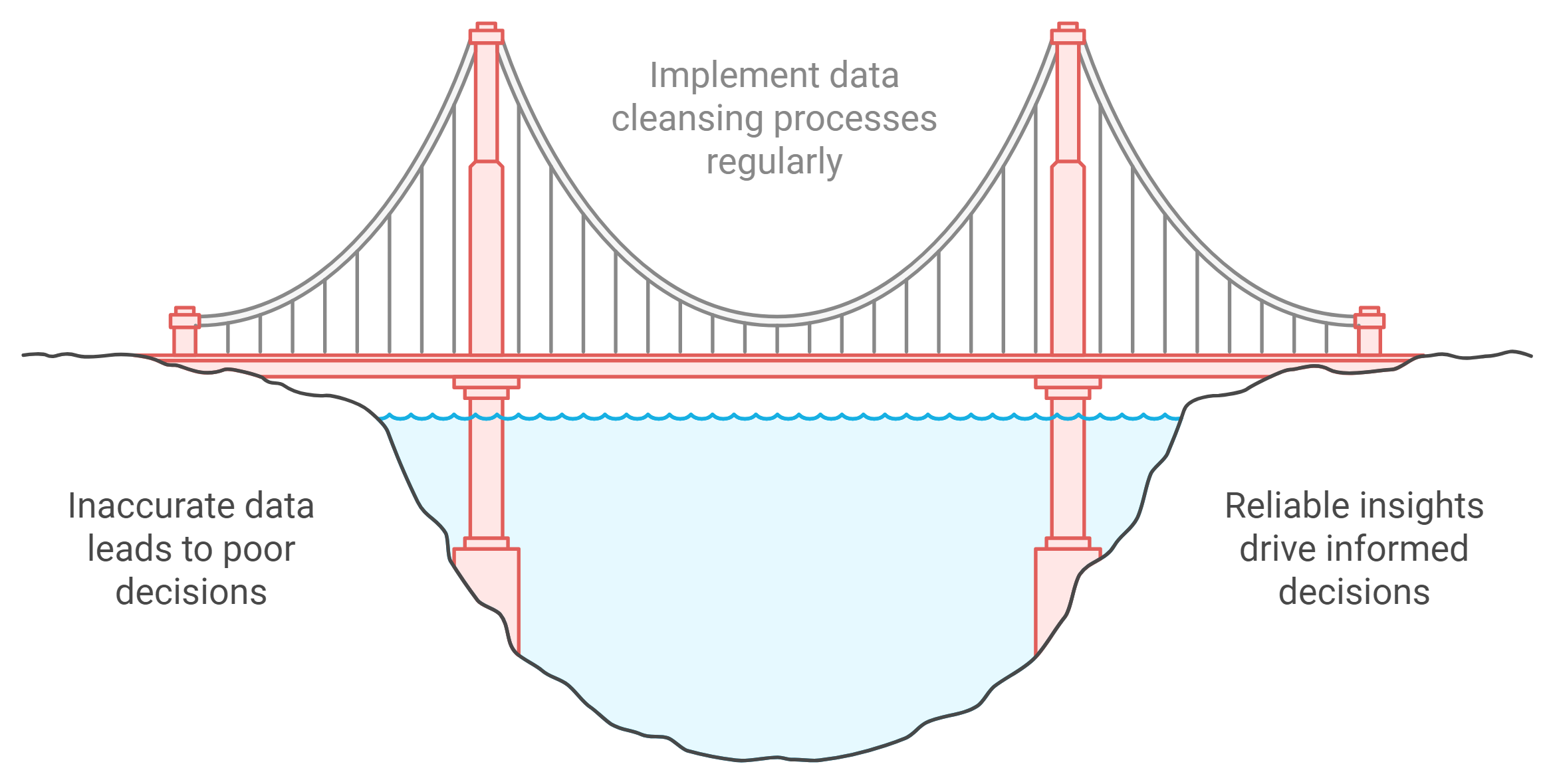
The Impact of Dirty Data on Analytics
Misleading Insights
Dirty data often leads to inaccurate conclusions. When your data contains errors, duplicates, or inconsistencies, the analytics derived from it become unreliable. For instance, a marketing campaign based on incorrect customer segmentation may target the wrong audience, wasting resources and missing potential leads. Poor-quality data skews your analysis, making it difficult to trust the insights you generate. This lack of trust can hinder your ability to make informed decisions, ultimately affecting your business outcomes.
A study by Gartner revealed that poor data quality costs businesses an average of $15 million annually, emphasizing the financial risks of relying on flawed data.
Increased Costs and Inefficiencies
Dirty data doesn’t just harm your analytics; it also drains your resources. Cleaning up errors after they’ve impacted your operations takes time and money. Duplicate entries inflate your database size, increasing storage costs. Inconsistent formats slow down data processing, requiring additional manual intervention. These inefficiencies reduce productivity and divert attention from strategic initiatives. By addressing dirty data proactively, you can avoid these unnecessary expenses and focus on achieving your business goals.
How Clean Data Enhances Analytics
Improved Accuracy and Reliability
Clean data ensures that your analytics are accurate and dependable. When your datasets are free from errors and inconsistencies, you can trust the insights they provide. For example, clean customer data allows you to identify trends, preferences, and behaviors with precision. This accuracy strengthens your ability to predict outcomes and plan effectively. Reliable data forms the backbone of successful analytics, giving you a competitive edge in your industry.
According to the Harvard Business Review, companies that prioritize data quality see a 70% improvement in decision-making accuracy.
Better Decision-Making
High-quality data empowers you to make better decisions. When your analytics are based on clean data, you gain a clearer understanding of your business environment. This clarity enables you to identify opportunities, mitigate risks, and allocate resources more effectively. For instance, clean sales data helps you forecast revenue accurately, guiding your investment strategies. By leveraging clean data, you can make decisions that drive growth and innovation.
Strengthened Stakeholder Confidence
Stakeholders rely on accurate data to evaluate performance and plan for the future. Clean data builds trust among your team, investors, and partners. When your analytics consistently deliver reliable insights, stakeholders feel confident in your organization’s direction. This confidence fosters collaboration and support, creating a strong foundation for success. Clean data not only enhances your analytics but also strengthens your relationships with key stakeholders.
The Managed Outsource Blog highlights that clean data improves usability and reliability, which are essential for maintaining stakeholder trust.
Steps to Perform Effective Data Cleansing
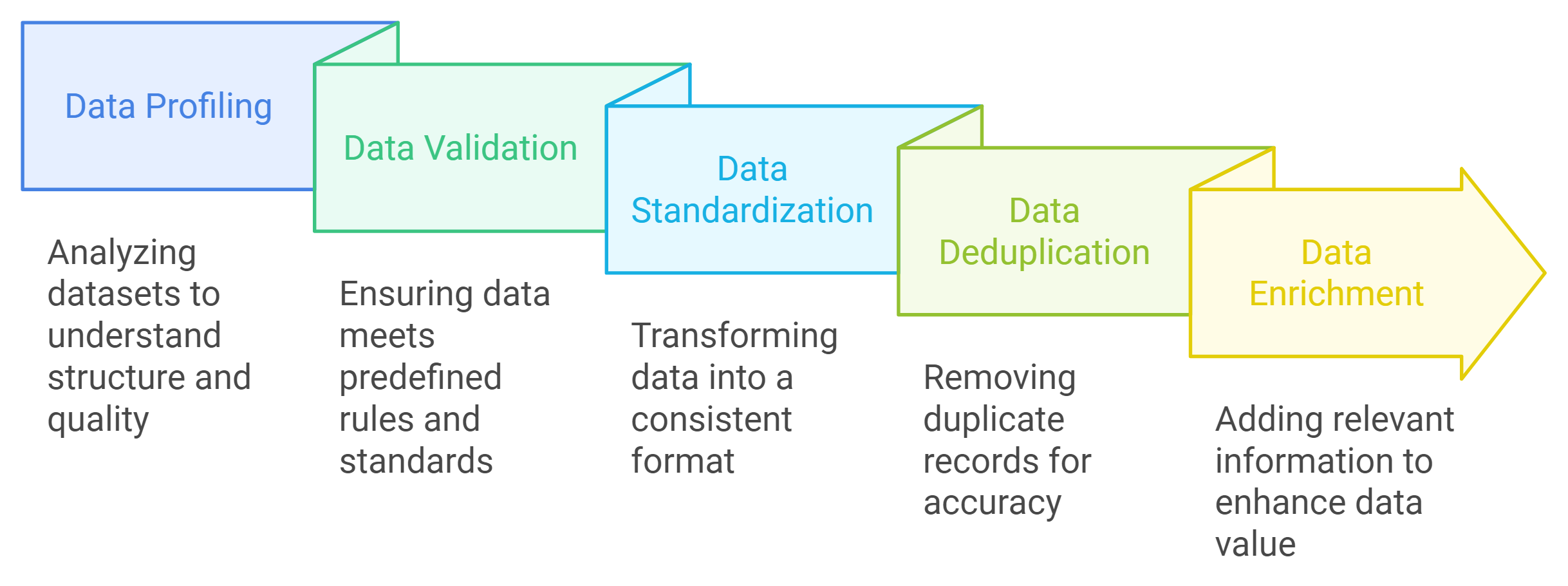
Step 1: Data Profiling
Data profiling serves as the foundation of effective data cleansing. It involves analyzing your datasets to understand their structure, relationships, and quality. By performing this step, you can identify issues such as missing values, duplicate entries, outliers, and inconsistencies. This process helps you uncover hidden problems that may compromise the accuracy of your analytics.
For example, if your dataset contains customer records, data profiling can reveal incomplete profiles or repeated entries. Addressing these issues early ensures that your data is ready for further processing. Profiling also provides insights into patterns and trends within your data, enabling you to make informed decisions about how to clean and organize it.
According to experts, data profiling not only identifies errors but also reduces the likelihood of future mistakes, ensuring long-term data quality.
Step 2: Data Validation
Data validation ensures that your data meets predefined rules and standards. This step verifies the accuracy, consistency, and completeness of your datasets. By validating your data, you can catch errors before they impact your analytics.
For instance, validation checks can confirm whether email addresses follow the correct format or if numerical fields fall within acceptable ranges. These checks prevent invalid data from entering your system, saving you time and resources in the long run. Validation also builds confidence in your data, as you can trust that it aligns with your business requirements.
Automated validation tools streamline this process, offering real-time error detection and correction. This approach enhances efficiency and minimizes manual effort.
Step 3: Data Standardization
Data standardization transforms your datasets into a consistent format, making them easier to process and analyze. This step eliminates variations in formatting, such as inconsistent date formats, currency symbols, or measurement units. Standardized data ensures seamless integration across systems and improves the reliability of your analytics.
For example, if your dataset includes dates written in multiple formats (e.g., MM/DD/YYYY and DD-MM-YYYY), standardization converts them into a single format. This uniformity reduces errors during analysis and enhances the overall quality of your data.
Experts emphasize that standardized data not only improves accuracy but also boosts the efficiency of data processing, enabling faster and more reliable insights.
By following these steps, you can create a robust data cleansing process that ensures your datasets are accurate, consistent, and ready for analysis. Each step plays a critical role in maintaining data quality, ultimately driving better analytics results.
Step 4: Data Deduplication
Data deduplication eliminates duplicate records from your datasets, ensuring accuracy and consistency. Duplicate entries often inflate your database size and distort analytics results. By removing these redundancies, you create a streamlined dataset that reflects the true state of your data.
To perform deduplication effectively, you need to identify and merge duplicate records. For instance, customer records with slight variations in names or addresses may represent the same individual. Advanced tools can help you detect these duplicates by analyzing patterns and similarities. Once identified, you can consolidate the information into a single, accurate record.
According to experts, deduplication not only improves data quality but also reduces storage costs and enhances processing speed.
Deduplication also prevents errors in analytics. For example, duplicate sales records can inflate revenue figures, leading to misleading insights. By addressing this issue, you ensure that your analytics reflect reality, enabling better decision-making. Deduplication is a critical step in maintaining data integrity and optimizing your analytics outcomes.
Step 5: Data Enrichment
Data enrichment enhances the value of your datasets by adding relevant information. This step fills in missing details, updates outdated records, and incorporates external data sources. Enriched data provides a more comprehensive view, enabling deeper insights and more informed decisions.
For example, enriching customer data with demographic or behavioral information allows you to create targeted marketing campaigns. Adding geographic data to sales records helps you identify regional trends and opportunities. Enrichment transforms raw data into a powerful asset that drives business growth.
Automated tools simplify the enrichment process by integrating data from multiple sources and ensuring accuracy. These tools save time and reduce manual effort, making enrichment more efficient.
Enriched data also improves the performance of analytics and AI models. Comprehensive datasets provide the context needed for accurate predictions and recommendations. By investing in data enrichment, you unlock the full potential of your analytics and gain a competitive edge in your industry.
Both deduplication and enrichment play vital roles in data cleansing. Deduplication ensures accuracy, while enrichment adds depth and value. Together, these steps create a robust foundation for analytics, empowering you to make smarter, data-driven decisions.
Tools and Techniques for Data Cleansing
Manual vs. Automated Data Cleansing
When it comes to data cleansing, you can choose between manual and automated approaches. Each method has its strengths and limitations, depending on your needs and resources.
Manual data cleansing involves reviewing and correcting data entries by hand. This approach gives you complete control over the process, allowing you to address specific issues with precision. However, it can be time-consuming and prone to human error, especially when dealing with large datasets. For smaller businesses or datasets, manual cleansing may suffice, but scaling this method becomes challenging as data grows.
Automated data cleansing, on the other hand, leverages software tools to identify and fix errors efficiently. These tools can handle large volumes of data, ensuring consistency and accuracy at a faster pace. Automation reduces the risk of human error and saves valuable time. For example, tools like WinPure Clean & Match offer user-friendly solutions for deduplication and correction, making them ideal for non-technical users or smaller teams. Automated methods are particularly beneficial for organizations that manage extensive databases or require regular data updates.
Choosing between manual and automated cleansing depends on your organization's size, data complexity, and available resources. While manual methods provide control, automation ensures efficiency and scalability.
Features of Effective Data Cleansing Tools
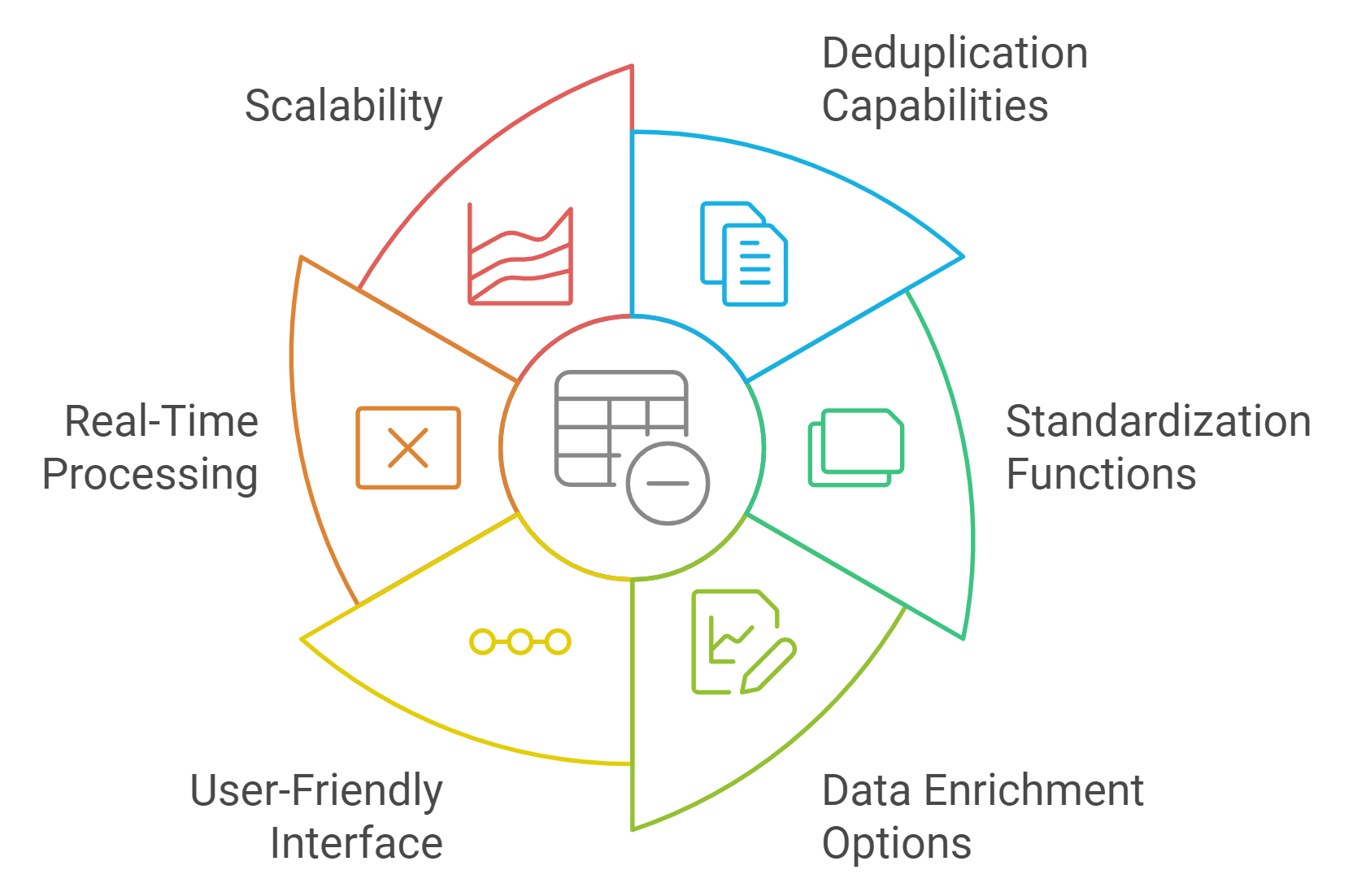
Not all data cleansing tools are created equal. To ensure you select the right tool, look for features that enhance accuracy, efficiency, and usability. Here are some key attributes to consider:
Deduplication Capabilities: Tools like DemandTools excel in identifying and merging duplicate records, even in large datasets. This feature ensures your data remains accurate and streamlined.
Standardization Functions: Effective tools should standardize formats, such as dates, currencies, and measurement units, to maintain consistency across datasets.
Data Enrichment Options: Tools like RingLead offer enrichment features, adding valuable information to your datasets for deeper insights.
User-Friendly Interface: Solutions like WinPure Clean & Match cater to non-technical users, providing intuitive interfaces that simplify the cleansing process.
Real-Time Processing: Tools such as Oracle Enterprise Data Quality enable real-time data validation and profiling, ensuring immediate error detection and correction.
Scalability: The ability to handle growing datasets is crucial. Tools like Informatica Cloud Data Quality offer scalable solutions that adapt to your organization's evolving needs.
By prioritizing these features, you can select a tool that aligns with your goals and enhances your data quality management.
Examples of Popular Tools for Data Cleansing
Several tools stand out for their ability to streamline and optimize the data cleansing process. Here are some popular options:
Oracle Enterprise Data Quality
This tool provides advanced features like address verification, real-time matching, and profiling. It integrates seamlessly with business applications, making it suitable for technical users managing complex datasets.RingLead
A comprehensive platform for CRM and marketing data, RingLead offers normalization, deduplication, and enrichment capabilities. It helps you maintain clean and actionable data for customer relationship management.WinPure Clean & Match
Designed for smaller businesses and non-technical users, this tool simplifies data cleansing with its intuitive interface. It supports deduplication, correction, and cleaning for databases, CRMs, and spreadsheets.Informatica Cloud Data Quality
This self-service tool empowers teams to maintain high-quality data through prebuilt rules for deduplication, enrichment, and standardization. Its scalability makes it ideal for organizations with growing data needs.DemandTools
Known for its bulk deduplication and data movement features, DemandTools streamlines CRM data management. It allows you to merge duplicates quickly and perform bulk updates or imports with ease.
Each of these tools offers unique advantages, catering to different organizational needs. Whether you require advanced technical features or user-friendly solutions, these tools can help you achieve cleaner, more reliable data.
The Benefits of Clean Data for Business Success
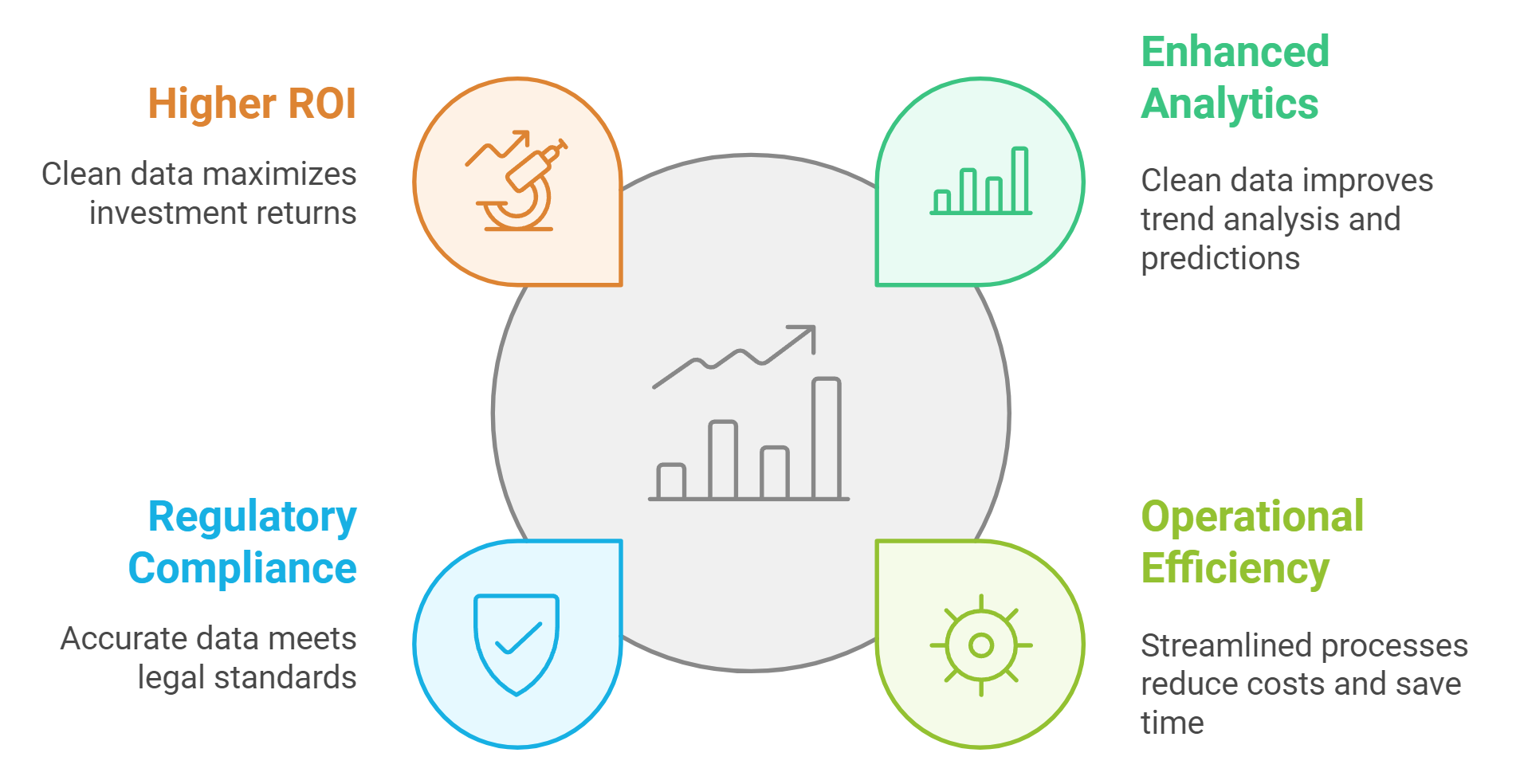
Enhanced Analytics and Insights
Clean data provides a solid foundation for generating accurate and actionable insights. When your data is free from errors, duplicates, and inconsistencies, it becomes a reliable resource for analytics. This reliability allows you to uncover trends, identify opportunities, and make predictions with confidence. For instance, clean customer data helps you segment your audience effectively, enabling personalized marketing strategies that drive better engagement and higher conversion rates.
According to industry experts, businesses that prioritize data quality experience a significant improvement in their decision-making processes, leading to more successful outcomes.
Clean data also enhances the performance of advanced technologies like artificial intelligence and machine learning. These systems rely on high-quality data to deliver precise results. By maintaining clean datasets, you ensure that your analytics tools and AI models operate at their full potential, giving you a competitive edge in your industry.
Improved Operational Efficiency
Clean data streamlines your operations by eliminating inefficiencies caused by errors and redundancies. Duplicate records, inconsistent formats, and outdated information often slow down processes and increase costs. By addressing these issues through data cleansing, you can optimize workflows and allocate resources more effectively.
For example, removing duplicate entries from your database reduces storage costs and improves processing speed. Standardizing data formats ensures seamless integration across systems, minimizing delays and errors during analysis. These improvements not only save time but also enhance productivity, allowing your team to focus on strategic initiatives.
A well-maintained database supports smoother operations, helping businesses achieve their goals faster and with fewer obstacles.
Clean data also reduces the need for manual intervention, which can be time-consuming and error-prone. Automated data cleansing tools simplify the process, ensuring consistent and accurate results. This efficiency translates into cost savings and better resource management, ultimately boosting your organization's overall performance.
Better Compliance with Regulations
Maintaining clean data is essential for meeting regulatory requirements and avoiding legal risks. Regulations like GDPR and CCPA mandate that businesses handle personal data responsibly, ensuring accuracy, security, and transparency. Dirty data, such as outdated or incorrect records, can lead to compliance violations and hefty fines.
Clean data helps you stay compliant by providing accurate and up-to-date information. For instance, ensuring that customer records are complete and correct allows you to respond promptly to data access or deletion requests. This compliance not only protects your organization from penalties but also builds trust with your customers, enhancing your reputation.
Experts emphasize that clean data plays a critical role in maintaining regulatory standards, safeguarding your business from potential legal challenges.
By investing in data cleansing, you demonstrate your commitment to ethical data practices. This commitment strengthens your relationships with stakeholders and positions your organization as a responsible and trustworthy entity in the market.
Higher ROI on Data-Driven Strategies
Clean data directly impacts the return on investment (ROI) of your data-driven strategies. When your data is accurate, consistent, and complete, it becomes a powerful asset that drives better outcomes across all business functions. Dirty data, on the other hand, leads to wasted resources, missed opportunities, and flawed decision-making.
Investing in data cleansing ensures that your marketing campaigns, sales efforts, and operational strategies yield maximum results. For example, clean customer data allows you to create highly targeted marketing campaigns. These campaigns reach the right audience with personalized messages, increasing engagement and conversion rates. Accurate data also helps you allocate budgets more effectively, ensuring that every dollar spent contributes to measurable results.
According to industry experts, businesses that prioritize data quality see a significant improvement in their ROI, as clean data reduces inefficiencies and enhances decision-making accuracy.
Clean data also supports better sales performance. By eliminating duplicate or outdated records, your sales team can focus on genuine leads and opportunities. This focus improves productivity and boosts revenue generation. Additionally, enriched data provides deeper insights into customer preferences and behaviors, enabling your team to tailor their approach and close deals more effectively.
Operational efficiency further contributes to higher ROI. Clean data streamlines processes, reduces errors, and minimizes manual intervention. Automated tools for data cleansing save time and resources, allowing your team to concentrate on strategic initiatives. For instance, removing inconsistencies in supply chain data ensures smoother operations, reducing delays and costs.
A study by Gartner highlights that poor data quality costs businesses millions annually, underscoring the financial benefits of maintaining clean data.
By investing in reliable data cleansing practices, you unlock the full potential of your data. Clean data not only enhances analytics but also drives profitability, making it a cornerstone of successful data-driven strategies.
Overcoming Challenges in Data Cleansing
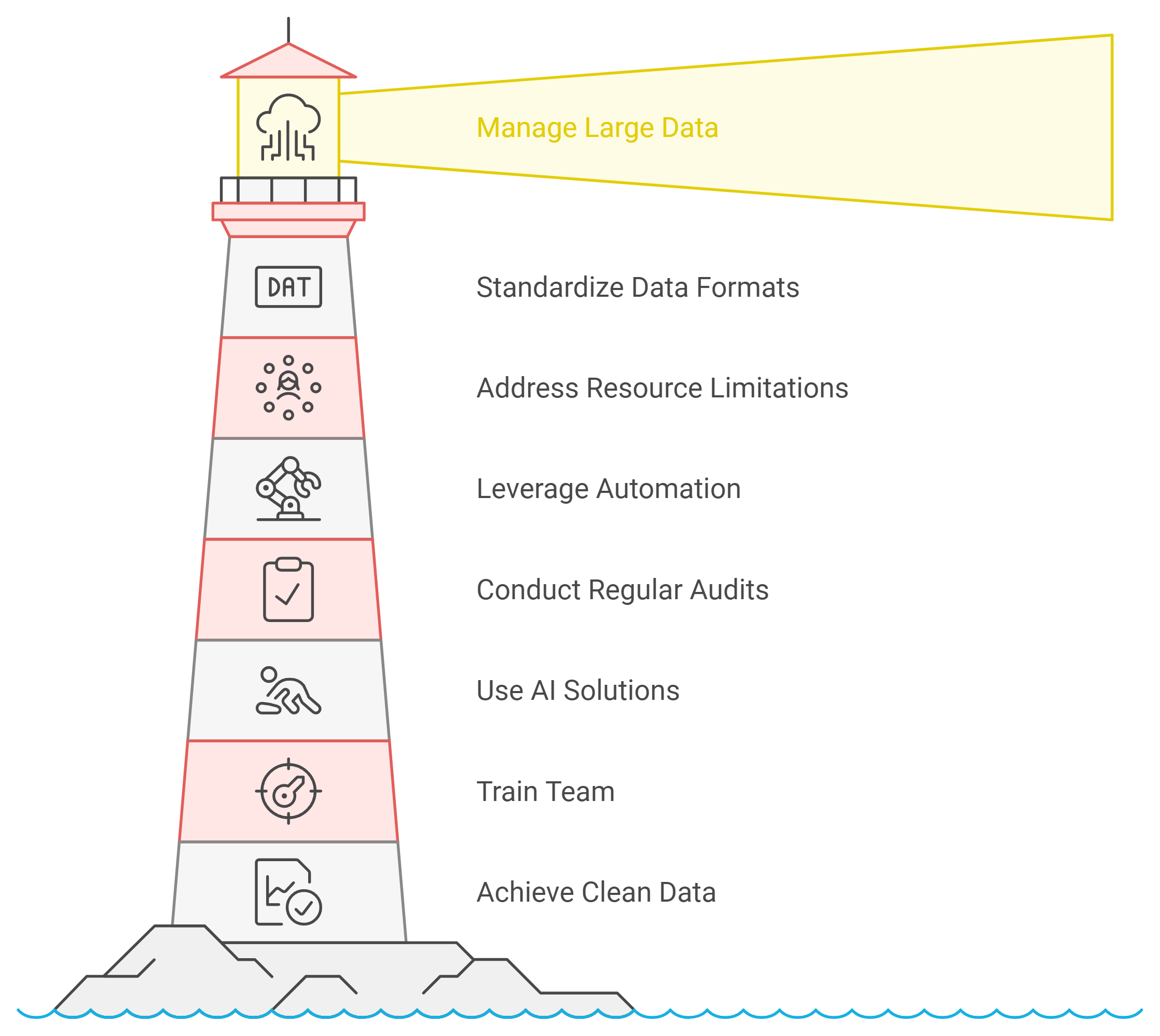
Managing Large Volumes of Data
Handling vast amounts of data can feel overwhelming, especially when errors and inconsistencies are scattered across multiple sources. Large datasets often contain duplicate entries, outdated information, and missing fields, which complicate the cleansing process. To tackle this challenge, you need a structured approach and the right tools.
Start by breaking your data into manageable segments. This segmentation allows you to focus on specific areas without feeling burdened by the entire dataset. Use data profiling techniques to identify patterns, inconsistencies, and errors within each segment. Profiling helps you understand the scope of the problem and prioritize areas that need immediate attention.
Automated tools play a crucial role in managing large datasets. Tools like Informatica Cloud Data Quality and Oracle Enterprise Data Quality can process extensive data volumes efficiently. These tools detect duplicates, standardize formats, and validate entries in real time, saving you hours of manual effort. Automation ensures consistency and reduces the risk of human error, making it an essential strategy for large-scale data cleansing.
According to industry experts, leveraging automation for data cleansing not only improves efficiency but also enhances the accuracy of your analytics.
By adopting these strategies, you can transform even the largest datasets into clean, reliable resources for analysis.
Addressing Lack of Standardization
Inconsistent data formats create significant barriers to effective analysis. Variations in date formats, currency symbols, and measurement units can lead to errors during processing. Lack of standardization also makes it difficult to integrate data from different sources, reducing its usability.
To address this issue, establish clear formatting rules for your datasets. Define a standard format for dates, currencies, and other critical fields, and ensure that all new data adheres to these guidelines. Data standardization tools, such as WinPure Clean & Match, can automate this process by converting inconsistent entries into a uniform format.
Regular audits help maintain standardization over time. Conduct periodic checks to identify and correct deviations from your established rules. These audits ensure that your data remains consistent and ready for analysis.
Experts emphasize that standardized data not only improves accuracy but also facilitates seamless integration across systems, enabling more insightful analyses.
By prioritizing standardization, you enhance the reliability of your data and simplify the analytics process.
Dealing with Limited Resources or Expertise
Limited resources or expertise can hinder your ability to cleanse data effectively. Small teams may lack the time or technical skills needed to address complex data issues, leading to delays and inefficiencies.
To overcome this challenge, start by investing in user-friendly tools designed for non-technical users. Solutions like WinPure Clean & Match and RingLead offer intuitive interfaces that simplify the cleansing process. These tools enable your team to perform tasks like deduplication, validation, and enrichment without requiring advanced technical knowledge.
Outsourcing is another viable option. Partnering with data management experts allows you to leverage their skills and experience while freeing up your internal resources. Outsourcing ensures that your data cleansing tasks are handled efficiently and accurately.
Training your team on data quality standards also makes a significant difference. Educate them on best practices for data entry, validation, and maintenance. A well-trained team minimizes errors at the source, reducing the need for extensive cleansing later.
According to research, organizations that prioritize training and adopt user-friendly tools see a marked improvement in data quality and operational efficiency.
By addressing resource and expertise limitations, you can build a robust data cleansing process that supports your business goals.
Solutions to Simplify the Process
Simplifying the data cleansing process can save time, reduce errors, and improve the overall quality of your data. By adopting effective strategies and tools, you can streamline this critical task and ensure your data remains accurate and reliable.
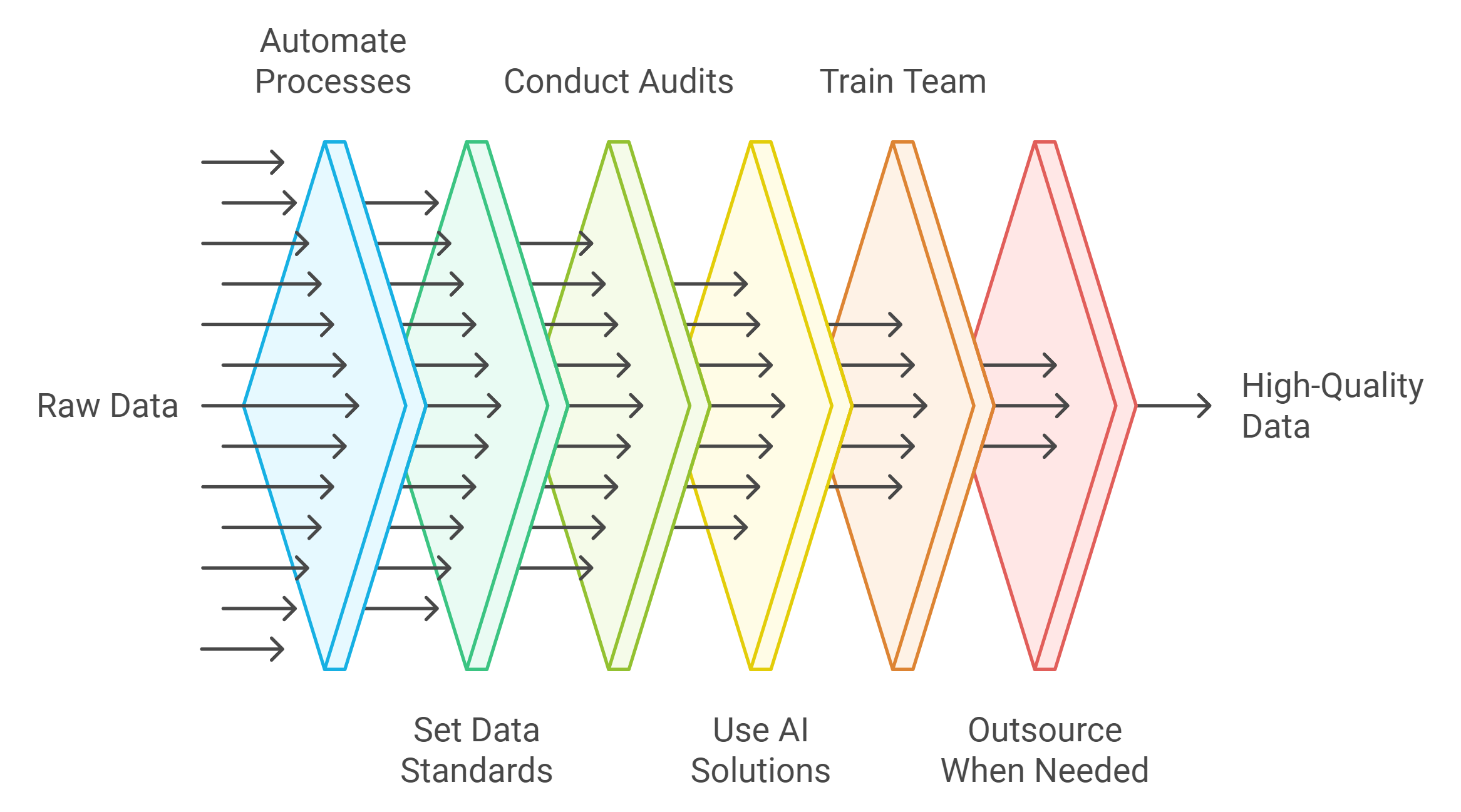
1. Leverage Automation Tools
Automation tools are a game-changer for data cleansing. They handle repetitive tasks like deduplication, validation, and standardization with speed and precision. Tools such as Informatica Cloud Data Quality and WinPure Clean & Match can process large datasets efficiently, reducing manual effort and minimizing human error. Automation also ensures consistency across your data, which is essential for accurate analytics.
According to industry experts, automated data cleaning reduces operational costs and increases productivity by eliminating manual intervention.
2. Establish Clear Data Standards
Defining clear data standards simplifies the cleansing process. Create guidelines for formatting, naming conventions, and acceptable values for each dataset. For example, standardize date formats to avoid inconsistencies during analysis. Clear standards ensure that all new data aligns with your requirements, reducing the need for extensive corrections later.
Experts emphasize that maintaining consistent data formats improves usability and enhances the accuracy of analytics.
3. Conduct Regular Data Audits
Frequent audits help you identify and address issues before they escalate. Schedule routine checks to monitor for duplicates, missing fields, or outdated information. Regular audits keep your data clean and ensure it remains a reliable resource for decision-making.
A well-maintained database supports better business efficiency and reduces the risk of costly errors.
4. Use AI-Driven Solutions
AI-driven tools enhance the data cleansing process by identifying patterns and anomalies that may go unnoticed. These tools can predict errors, suggest corrections, and even enrich your data with external sources. AI-powered solutions not only improve accuracy but also provide deeper insights for informed decision-making.
Research shows that AI-driven data cleaning boosts operational efficiency and enhances the reliability of analytics.
5. Train Your Team on Best Practices
Educating your team on data quality standards ensures that errors are minimized at the source. Provide training on proper data entry, validation techniques, and the use of cleansing tools. A well-trained team contributes to maintaining high-quality data and reduces the need for extensive corrections.
Organizations that invest in training see fewer errors and improved data accuracy, leading to better business outcomes.
6. Outsource When Necessary
If your team lacks the resources or expertise to manage data cleansing effectively, consider outsourcing to professionals. Data management experts bring specialized skills and tools to the table, ensuring your data is cleaned thoroughly and efficiently. Outsourcing allows your team to focus on strategic initiatives while maintaining data quality.
Partnering with experts can save time and ensure compliance with data standards, especially for complex or large-scale projects.
By implementing these solutions, you can simplify the data cleansing process and unlock the full potential of your data. Clean data not only enhances analytics but also drives better decision-making and operational efficiency.
Best Practices for Maintaining Data Quality
Establishing Data Governance Frameworks
You need a solid data governance framework to maintain data quality over time. This framework defines the rules, responsibilities, and processes for managing your data. It ensures consistency and accountability across your organization.
Start by assigning a dedicated team or individual to oversee data governance. This team should establish clear policies for data entry, storage, and usage. For example, they can create guidelines for formatting customer information or standardizing product codes. These rules help prevent errors and inconsistencies from entering your system.
A governance framework also promotes collaboration. When everyone follows the same standards, your data becomes more reliable and easier to use. This consistency improves your analytics and decision-making processes.
According to experts, organizations with strong data governance frameworks experience fewer errors and higher data accuracy, leading to better business outcomes.
By implementing a governance framework, you take control of your data and ensure its quality remains high.
Conducting Regular Data Audits
Regular data audits are essential for identifying and fixing issues before they escalate. These audits help you spot errors like duplicates, missing fields, or outdated information. By addressing these problems early, you keep your data accurate and reliable.
Schedule audits at consistent intervals, such as monthly or quarterly. During each audit, review your datasets for common issues. For example, check for duplicate customer records or inconsistent date formats. Use automated tools to streamline this process and save time.
Audits also provide valuable insights into your data's overall health. They reveal patterns and trends that can guide your data management strategies. For instance, if you notice frequent errors in a specific field, you can adjust your data entry process to prevent future mistakes.
A well-maintained database supports smoother operations and reduces the risk of costly errors, according to industry research.
By conducting regular audits, you ensure your data remains a trustworthy resource for analytics and decision-making.
Training Teams on Data Quality Standards
Your team plays a crucial role in maintaining data quality. Without proper training, even the best tools and processes can fall short. Educating your team on data quality standards ensures they understand their responsibilities and follow best practices.
Start by providing clear guidelines for data entry and validation. Teach your team how to spot and correct errors, such as typos or missing fields. For example, show them how to verify email addresses or standardize phone numbers. These small steps can make a big difference in your data's accuracy.
Offer ongoing training sessions to keep your team updated on new tools and techniques. Encourage them to ask questions and share feedback. This collaborative approach fosters a culture of accountability and continuous improvement.
Organizations that invest in training see fewer errors and improved data accuracy, which leads to better business outcomes.
By empowering your team with the right knowledge and skills, you create a strong foundation for maintaining data quality.
Leveraging Automation for Continuous Cleansing
Automation transforms how you maintain data quality. It ensures your datasets stay accurate, consistent, and reliable without constant manual intervention. By integrating automated tools into your data management processes, you can achieve continuous cleansing and unlock the full potential of your analytics.
Why Automation Matters
Manual data cleansing often consumes time and resources. Errors slip through, especially when dealing with large datasets. Automation eliminates these challenges by streamlining repetitive tasks like deduplication, validation, and standardization. Tools equipped with advanced algorithms detect and correct errors faster than any manual process.
According to industry experts, businesses that adopt automation for data cleansing see a significant reduction in operational costs and an increase in data accuracy.
Automated systems also ensure consistency. They apply predefined rules across all datasets, reducing discrepancies and improving the reliability of your analytics. This consistency builds trust in your data and enhances decision-making.
Key Benefits of Continuous Cleansing
Real-Time Error Detection
Automated tools identify and fix errors as they occur. For example, they can flag invalid email addresses or duplicate entries during data entry. This real-time approach prevents flawed data from entering your system.Improved Efficiency
Automation speeds up the cleansing process. Tasks that once took hours can now be completed in minutes. This efficiency allows your team to focus on strategic initiatives rather than tedious data corrections.Scalability
As your business grows, so does your data. Automated tools handle increasing volumes effortlessly, ensuring your datasets remain clean and usable. This scalability supports your long-term data management goals.Enhanced ROI
Clean data directly impacts your bottom line. Accurate customer segmentation and targeting lead to higher ROI on marketing campaigns. Improved data quality strengthens sales and business relationships, driving growth.
A survey revealed that clean data significantly boosts ROI and enhances customer targeting, highlighting the financial benefits of continuous cleansing.
How to Implement Automation
Choose the Right Tools: Select tools that align with your needs. Look for features like real-time validation, deduplication, and enrichment. User-friendly interfaces make adoption easier for your team.
Set Clear Rules: Define standards for data formats, naming conventions, and acceptable values. Automated tools follow these rules to maintain consistency.
Monitor and Adjust: Regularly review the performance of your automated systems. Make adjustments to rules and processes as your business evolves.
Final Thoughts
Automation ensures your data remains clean and actionable over time. It reduces errors, saves resources, and enhances the accuracy of your analytics. By leveraging automation for continuous cleansing, you create a strong foundation for data-driven success.
How Data Cleansing Drives Better Analytics Results
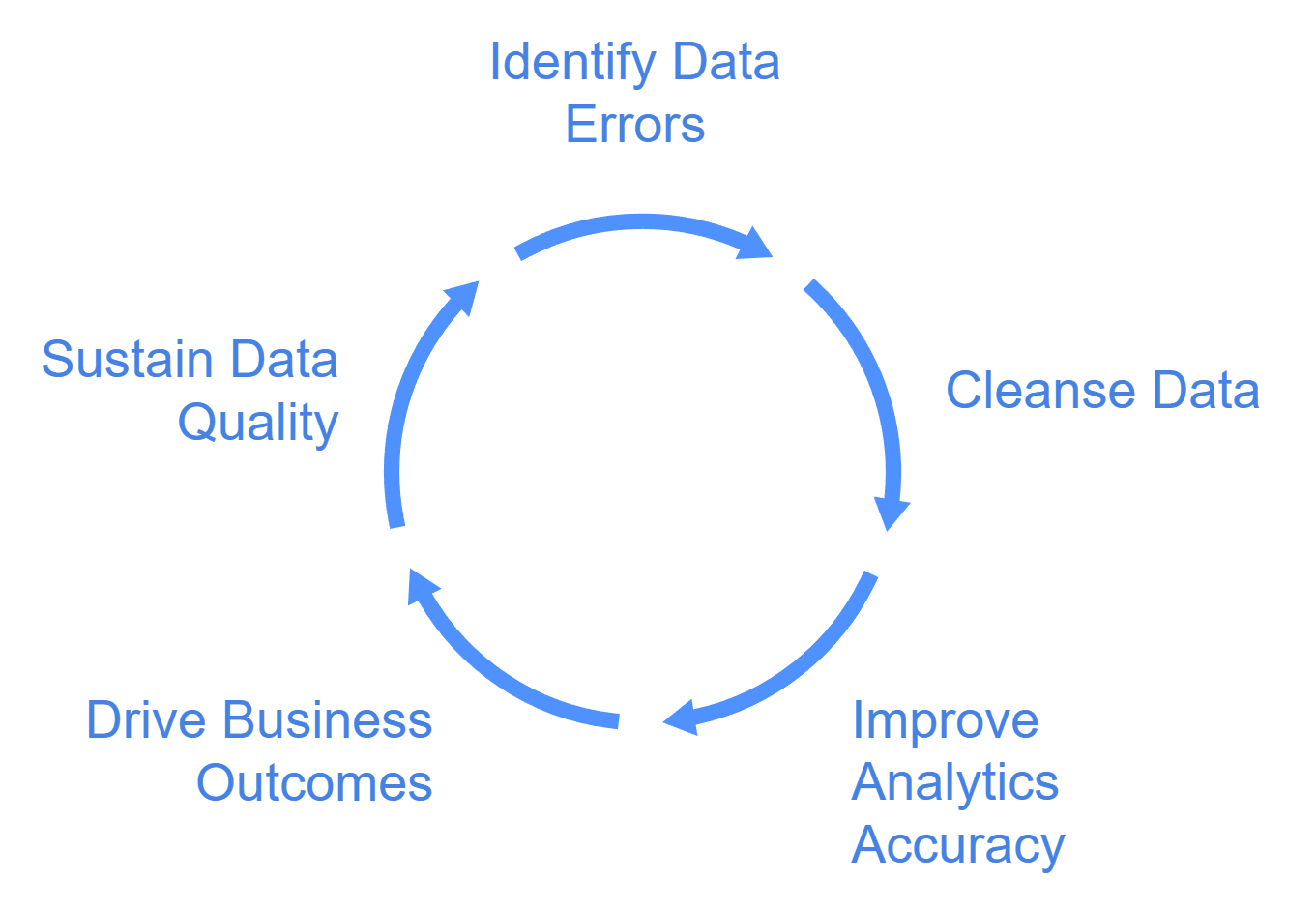
The Connection Between Data Quality and Analytics Accuracy
Data quality directly impacts the accuracy of your analytics. When your data is clean, it provides a reliable foundation for generating insights. Errors, inconsistencies, or duplicates in your datasets can distort your analysis, leading to flawed conclusions. For example, a typo in a customer record might create duplicate entries, inflating your metrics and skewing your results. As Susan Walsh, a data management expert, explains, "A simple typo can lead to chaos. It’s like having two identical ice cream cones when you only wanted one!" This analogy highlights how even small errors can disrupt your analytics.
Clean data ensures that your analytics reflect reality. Accurate datasets allow you to identify trends, predict outcomes, and make informed decisions. Without this accuracy, your business risks wasting resources on misguided strategies. By prioritizing data cleansing, you eliminate errors and inconsistencies, creating a trustworthy resource for analysis. This reliability builds confidence in your analytics and strengthens your decision-making process.
Real-World Examples of Success with Clean Data
Many organizations have experienced significant success by investing in data cleansing. For instance, a global retail company once faced challenges with duplicate customer records. These duplicates inflated their database size and led to inaccurate sales forecasts. After implementing a robust data cleansing strategy, they eliminated redundancies and standardized their datasets. This effort improved their analytics accuracy, enabling them to target customers more effectively and increase revenue.
Another example comes from a healthcare provider that struggled with outdated patient records. These inaccuracies caused delays in treatment and compliance issues. By cleansing their data, they ensured that patient information was current and accurate. This improvement enhanced operational efficiency and strengthened patient trust.
These examples demonstrate the transformative power of clean data. Whether you manage customer records, financial data, or operational metrics, data cleansing helps you unlock the full potential of your analytics. Clean data not only enhances accuracy but also drives better outcomes across all areas of your business.
Long-Term Value of Investing in Data Cleansing
Investing in data cleansing delivers long-term benefits that extend beyond immediate analytics improvements. Clean data supports sustainable growth by ensuring that your datasets remain accurate and reliable over time. As Susan Walsh aptly puts it, "Think of data like a garden. If you neglect the weeds, they multiply." Regular data cleansing prevents errors from accumulating, maintaining the quality of your data and avoiding costly setbacks.
Clean data also enhances your organization's adaptability. As your business evolves, accurate datasets enable you to respond quickly to changes and seize new opportunities. For example, clean customer data allows you to pivot your marketing strategies based on shifting consumer preferences. This agility gives you a competitive edge in a rapidly changing market.
Moreover, data cleansing fosters trust among stakeholders. Reliable data builds confidence in your analytics, strengthening relationships with investors, partners, and customers. This trust creates a solid foundation for collaboration and long-term success.
By prioritizing data cleansing, you invest in the future of your business. Clean data not only drives better analytics results but also supports growth, innovation, and resilience. The value of this investment becomes evident as your organization achieves greater efficiency, accuracy, and profitability.
Data cleansing lays the groundwork for accurate analytics and smarter decision-making. Clean data builds trust in your insights, enhances operational efficiency, and ensures compliance with regulations. Begin by conducting a thorough data audit to pinpoint areas needing improvement. Implement cleansing practices to address errors and inconsistencies. To maintain long-term data quality, leverage automated tools that simplify the process and reduce manual effort. By prioritizing clean data, you empower your organization to achieve better outcomes and unlock the full potential of your analytics.
See Also
The Impact of Data Governance on Data Science Innovation
Data Governance's Importance in Maintaining Data Integrity
Data Analytics Mastery: Perspectives from Microsoft MVP Rishi Sapra
Achieving Business Success Through Effective Data Leadership
